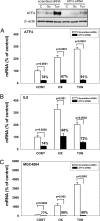Identification of inflammatory gene modules based on variations of human endothelial cell responses to oxidized lipids
- PMID: 16912112
- PMCID: PMC1568918
- DOI: 10.1073/pnas.0605457103
Identification of inflammatory gene modules based on variations of human endothelial cell responses to oxidized lipids
Abstract
Oxidized phospholipids are thought to promote atherogenesis by stimulating endothelial cells (ECs) to produce inflammatory cytokines, such as IL-8. In studies with mouse models, we previously demonstrated that genetic variation in inflammatory responses of endothelial cells to oxidized lipids contributes importantly to atherosclerosis susceptibility. We now show that similar variations occur in cultured aortic ECs derived from multiple heart transplant donors. These variations were stably maintained between passages and, thus, reflect either genetic or epigenetic regulatory differences. Expression array analysis of aortic EC cultures derived from 12 individuals revealed that >1,000 genes were regulated by oxidized phospholipids. We have used the observed variations in the sampled population to construct a gene coexpression network comprised of 15 modules of highly connected genes. We show that several identified modules are significantly enriched in genes for known pathways and confirm a module enriched for unfolded protein response (UPR) genes using siRNA and the UPR inducer tunicamycin. On the basis of the constructed network, we predicted that a gene of unknown function (MGC4504) present in the UPR module is a target for UPR transcriptional activator ATF4. Our data also indicate that IL-8 is present in the UPR module and is regulated, in part, by the UPR. We validate these by using siRNA. In conclusion, we show that interindividual variability can be used to group genes into pathways and predict gene-gene regulatory relationships, thus identifying targets potentially involved in susceptibility to common diseases such as atherosclerosis.
Conflict of interest statement
Conflict of interest statement: W.-P.Y., A.H., A.T., and T.G.K. are employees of Bristol–Myers Squibb Pharmaceutical Research Institute.
Figures




References
-
- Libby P. Nature. 2002;420:868–874. - PubMed
-
- Lusis A. J., Mar R., Pajukanta P. Annu. Rev. Genomics Hum. Genet. 2004;5:189–218. - PubMed
-
- Berliner J. A., Watson A. D. N. Engl. J. Med. 2005;353:9–11. - PubMed
-
- Shi W., Haberland M. E., Jien M. L., Shih D. M., Lusis A. J. Circulation. 2000;102:75–81. - PubMed
-
- Shi W., Wang N. J., Shih D. M., Sun V. Z., Wang X., Lusis A. J. Circ. Res. 2000;86:1078–1084. - PubMed
Publication types
MeSH terms
Substances
Grants and funding
LinkOut - more resources
Full Text Sources
Other Literature Sources
Molecular Biology Databases

